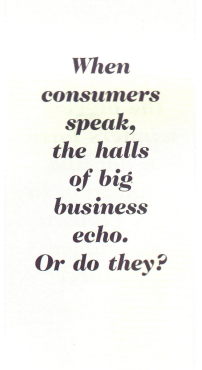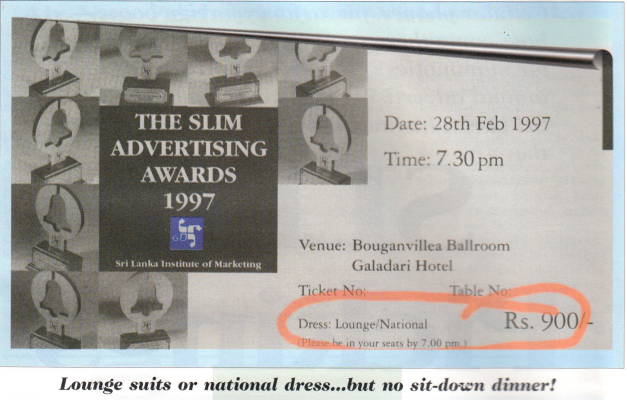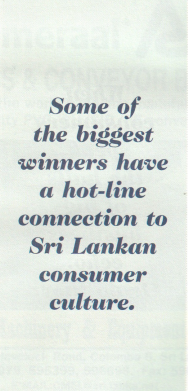He’ll deny it, of course, but any adman worth his fifteen percent secretly believes those marketing types can’t tell the difference between a good ad and a hole in the ground. The marketing men know this, so it was very sporting of them to ask a panel composed mostly of advertising people to judge the best ads of 1996 at this year’s Sri Lanka Institute of Marketing (SLIM) Advertising Awards.

Very sporting Maybe, a bit risky. Not that I fault the choices made by the panel of six agency heads, a creative director, a former J Walter Thompson account director and Amitava Chatterjee, marketing and sales director at Reckitt & Colman. On the contrary. I thought their selections fairly representative of the best of contemporary Sri Lankan advertising. Of course, it’s hardly surprising that I should think so I’m an adman myself. The standards I use to judge advertising are the same ones used by the judges: the common standards of our profession.
Elsewhere in this magazine I argue that the only worthwhile judgements about advertising are made by consumers. Those judgements are rarely spoken out loud. but they are expressed all right down at the local ‘daily needs shop, where the housewife fills her shopping basket, and on the annual balance sheets of large marketing companies. When the consumer speaks, the halls of big business echo.
Or do they
Looking at Friday night’s winners, I have to admit that advertising has come a long way since I quit the agency business for the risky world of the freelance. Today’s ads are cleverer. They look and sound better. I don’t think the credit for this belongs to the admen. The people who create the ads today are largely the same lot who’ve been doing it for the last decade or so. Their output hasn’t changed that much. What has changed is the willingness of the best marketing people to leave creative decisions up to the ad agency. In the old days, they tried to write and design the ads themselves, with predictably hideous results. Obviously they trust the agencies more now. From an adman’s point of view, that’s a healthy development.
Healthier still was the fact that some of the biggest winners at the SLIM Awards were created by people who seem to have a hot-line connection to Sri Lankan middle class (ie. consumer) culture. J. Walter Thompson’s Lipton Laojji campaign-which received gold awards for overall best TV commercial, best radio commercial in the Food & Beverage category and overall best campaign was a case in point. So were the excellent ads for Two Elephants safety matches. which won two silver awards in the Fast Moving Consumer Goods category and a gold award for overall best radio commercial The Two Elephants ads were by two separate agencies, Tradlanka and Yoshi, which argues a substantial and positive client input.
These are great campaigns for ordinary, workaday products but sadly, too many other winners were for products and services catering to the upmarket Colombo crowd.
As the evening progressed, we saw scads of ads for luxury cars, cellular phones, floor tiles, fashion clothing pizza, first-class air tickets and fancy foreign booze What happened to all the hand tractors, motor oil, lottery tickets, agro-chemicals, headache pills, plastic buckets
and mammoties? Are these products too boring to inspire creativity? Or is it that advertising and marketing people do their best work on the upmarket stuff, because they’re pretty upmarket fellows themselves? The loudest applause of the evening was heard when LDB Lintas won overall best press advertisement of the year with one of its ads for Caterpillar generators you know, the ones that look like movie posters and keep threatening you with another power cut. I applauded, too love those ads. And I’m sure they work. since they are pitched at a fairly sophisticated audience (wealthy private-sector industrialists). But how gensets will Caterpillar shift this year? A thousand? Five thousand? Ten? Compare that with, say, the number of Horse Brand candles that were bought last Friday night alone, all over the country. Why don’t we see more award- winning ads for candles?

The over-emphasis on upmarket products and services reflects two things. One, the taste of advertising people who-naturally enough-love the clever, aesthetically pleasing advertisements which are the most exquisite products of their art. And two, the conventional marketing wisdom which holds that Sri Lankans are ‘not yet mature’ enough to appreciate and respond to creativity and good taste-unless they happen to be rich.
Suresh Murugaser, chairman of the SLIM Awards organizing committee, opines that SLIM has “set a benchmark in terms of the quality of the awards” this time around. I haven’t been following closely enough over the years to judge if he’s right, though I suspect he is. But SLIM can do better if it wants. Here’s my suggestion for next year’s committee. Instead of asking advertising people to judge their own output, why not take the radical step of asking consumers?

Select a dozen or so from all over the country, using the same methods and criteria that are used to choose people for jury service (most products and services are used by middle-class people, the sort of people who serve on juries). Lock them up in a luxury hotel for the weekend, show them the year’s entries, and ask them to choose the winners. That way, you’ll be getting your judgement from the highest court of all-the court of the people. And (I’m sure this will be a relief) you won’t have to struggle with ‘Olympic balloting systems and other tortuous methods of keeping the judges honest.

I bet you’ll be surprised at the results.
A couple of other suggestions while I’m at it: first, how about a little more light to see and be seen by? The SLIM awards are, or should be, an opportunity for adpeople to get together, exchange gossip and reaffirm their sense of community. This is not easy when you’re cooped up in the dark like a broiler chicken, with only about forty-five minutes of light allowed you for dashing from bathroom to buffet and back to your coop. Next time, keep the lights on longer, so that people can mix and mingle. Second, either sell fewer tickets or move to a larger venue. The Galadari ballroom was crammed on Friday night, and people walking up to collect their awards had to squeeze uncomfortably between tables to reach the stage. Not a very nice way to treat people who are enjoying the biggest night of their professional year.
But I must admit I had a good time, and I wasn’t the only one. In the loo after dinner I met an agency head who was positively ecstatic. “Just imagine, machang”. he burbled. “we entered an ad to get two tickets and guess what? The damn thing won an award!” Now there’s one adman who went home happy.


